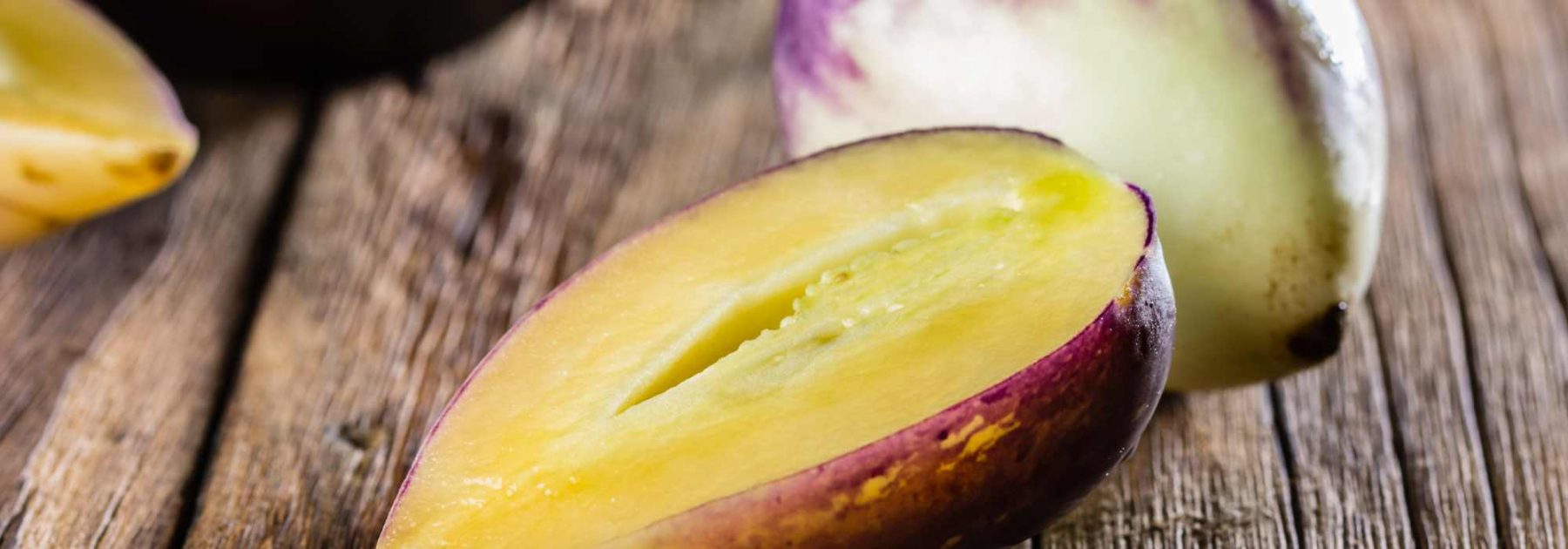
How to grow the pepino melon, an original exotic fruit? **Introduction** The pepino melon (*Solanum muricatum*), also known as the melon pear, is a fascinating fruit with a sweet, refreshing flavour reminiscent of melon and pear. Native to South America, this exotic plant can be grown in the UK with the right care. Here’s how to cultivate this unique fruit in your garden or greenhouse. **Choosing the Right Variety** Several pepino melon cultivars are available, each with slightly different fruit shapes and flavours. Popular varieties include ‘Golden Litestripe’ and ‘Ecuadorian Gold’. Select a variety suited to your climate—greenhouse cultivation is often best in cooler regions. **Planting Conditions** - **Soil**: Well-draining, fertile soil with a slightly acidic to neutral pH (6.0–7.0). - **Sunlight**: Full sun (at least 6–8 hours daily). - **Temperature**: Thrives in warm conditions (15–25°C). Protect from frost. **Planting Method** 1. **Sowing Seeds**: Start indoors in early spring (February–March). Sow seeds in trays and keep at 18–20°C. 2. **Transplanting**: Move seedlings outdoors after the last frost, spacing them 60–90cm apart. 3. **Greenhouse Growing**: Ideal for cooler climates—plant in large pots or grow bags. **Care Tips** - **Watering**: Keep soil consistently moist but not waterlogged. - **Feeding**: Apply a balanced fertiliser every 2–3 weeks during growth. - **Pruning**: Pinch out side shoots to encourage bushier growth and better fruiting. **Harvesting** Pepino melons ripen in late summer to autumn. Harvest when the fruit turns yellow or develops purple stripes and yields slightly to gentle pressure. **Common Issues** - **Pests**: Watch for aphids and whiteflies—use organic sprays if needed. - **Diseases**: Avoid overwatering to prevent root rot. **Conclusion** With its unique flavour and attractive appearance, the pepino melon is a rewarding addition to any garden. Whether grown in a greenhouse or a sunny spot outdoors, this exotic fruit is sure to impress. Happy gardening! Would you like recommendations for companion plants or recipe ideas? Let us know in the comments!
Sowing, planting, care and harvest of the pepino
Contents
Imagine a fruit with juicy, sweet flesh, combining the sweetness of a pear with the exotic flair of a melon. The pear melon, or Solanum muricatum, is a botanical curiosity that is winning over more and more gardeners. Native to the Andes, this surprising fruit adapts remarkably well to our climate, offering a unique taste experience and a touch of originality to the vegetable garden. It is also a rather vigorous shrubby plant that produces lovely white and mauve flowering, enhanced by yellow anthers. However, the fruits require plenty of warmth to reach ripeness.
Discover all the cultivation secrets of the melon pear, from seed to harvest, so you too can enjoy the delights of this little-known fruit!
What exactly is a pepino melon? *(Note: "Poire-melon" is commonly known as "pepino melon" or "pepino dulce" in English. The botanical name Solanum muricatum should remain unchanged if mentioned.)*
The pepino (Solanum muricatum), also known as melon pear, is a plant from the Solanaceae family. This makes it a close relative of the tomato, potato, and aubergine. Native to South America, particularly the Andes, this perennial plant—often grown as an annual in our climates—was reportedly discovered by the Conquistadors, though it failed to capture their interest. It was the Prussian botanist Gustav Wallis who introduced it to France around 1875, hence its alternative name, Wallis’ nightshade. Indeed, it is a type of nightshade, closely related to Balbis’ nightshade (Solanum sisymbrifolium).
The pepino (also called melon-pear) forms a compact bush, with entire, lanceolate, downy leaves in a deep green shade, and white and purple flowers that bloom between June and August. These star-shaped flowers feature striking golden-yellow anthers, inevitably reminiscent of those of potatoes or tomatoes—only prettier. Highly vigorous and well-branched, this shrubby plant can reach up to 1m in height with a spread of around 50cm. However, it is not frost-hardy in our climates.
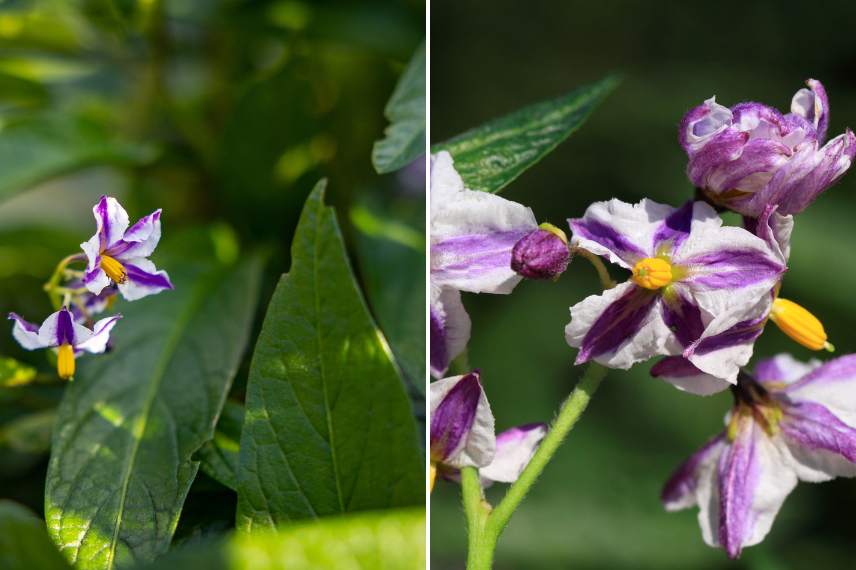
Foliage and flowers of the pepino
Its fruits, oval and elongated, roughly the size of a pear, have smooth skin that turns yellow streaked with purple at ripeness. The juicy, fragrant flesh recalls melon, with a slight acidity that lends a refreshing flavour. They are rich in vitamins C and A, a good source of potassium and fibre, and low in calories.
When and how to sow the pepino melon?
Sowing pear-melon seeds should be done indoors between February and March, depending on the region and growing conditions. Indeed, if you wish to grow pear-melon in a greenhouse, sowing can begin as early as February. Generally, the seeds are sown in trays at the same time as tomatoes, courgettes, and other sun-loving vegetables. A temperature of 16 to 20°C is required for the seeds to germinate.
Indoor sowing
- Use trays, seed boxes, or alveolate plug trays for sowing
- Fill them two-thirds full with special sowing compost, lightly moistened
- Sow the seeds at a depth of 0.5 cm
- Cover with a very thin layer of compost
- Water gently with a spray bottle using water at room temperature
- Cover your sowings with plastic film or a glass pane. Remember to ventilate regularly
- Place your containers in a bright spot, out of direct sunlight.
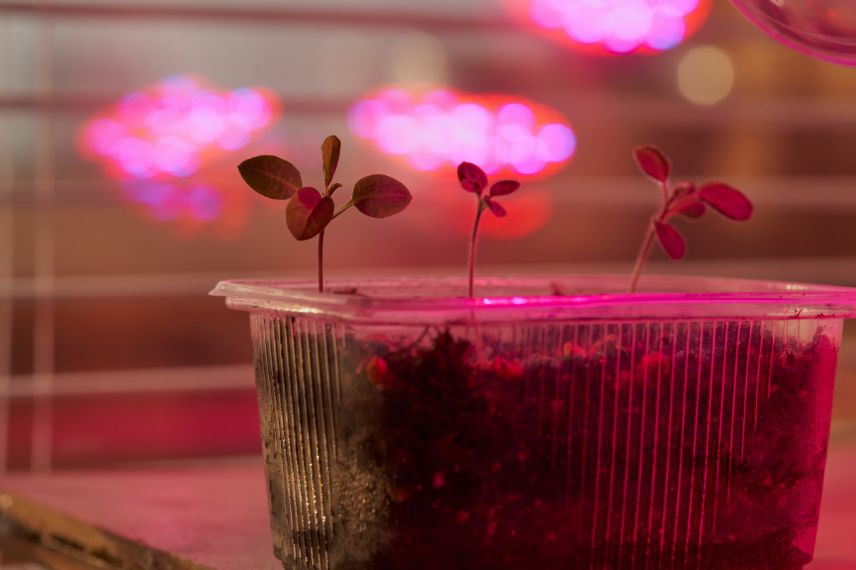
Pear-melon sowing
Germination occurs within about ten days. The pear-melon particularly enjoys warmth, so maintaining a constant temperature is essential. Similarly, the substrate should be kept consistently moist but not waterlogged. Also, remember to rotate your containers so all seedlings receive equal light exposure.
Transplanting into buckets
When the seedlings have four true leaves (excluding cotyledons), transplant them into buckets, filled with special sowing compost. Water regularly and keep the buckets in a warm place.
They will need to be gradually acclimatised to outdoor conditions before planting in the ground.
When, where and how to transplant pips?
Planting pepino seedlings outdoors takes place after the last frosts, usually from mid-May to June, to avoid any risk of late frosts. Given that the pepino needs a lot of heat, it can be planted in a greenhouse in regions where summers are less hot and shorter. However, in the southern half of the country, it is possible to plant the pepino directly in the ground.
Some even grow this Solanaceae in pots on a balcony or terrace. In this case, it will be cultivated as a perennial and overwintered in a conservatory throughout the winter, then brought back out in spring. This is actually the best way to obtain fruit in regions with shorter summers, though you will need to wait a year.
To save you time, we offer our pepino young plants in buckets.
Planting in the ground
Choose a very sunny spot, well sheltered from cold winds and draughts. The soil should be rich, rather light and perfectly drained.
- Work the soil to loosen it well
- Add mature compost or well-rotted manure
- Dig a hole three times larger than the buckets
- Plant the pepinos, leaving at least 60 to 80 cm between each young plant
- Stake the young plants to support the fruit.
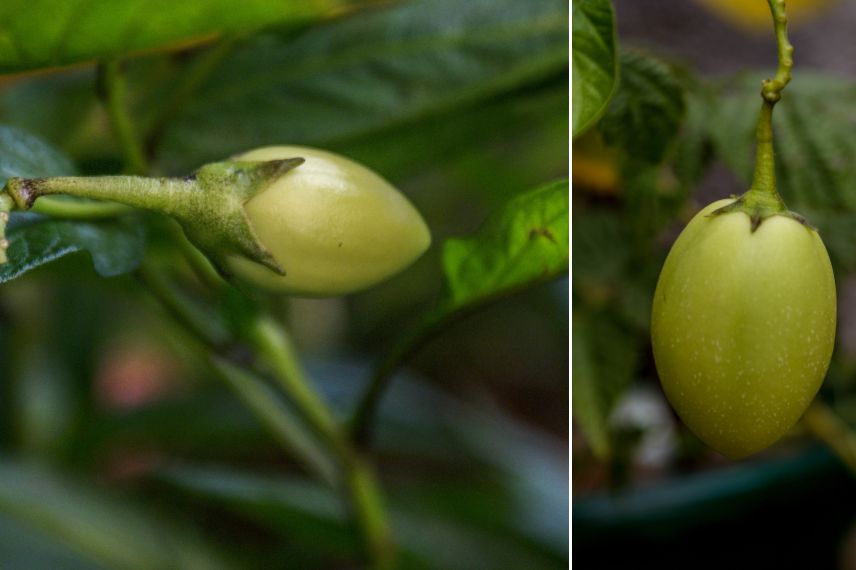
Pepino during ripening phase
Pot planting
Choose a sufficiently large pot, at least 30 cm in diameter, preferably made of terracotta.
- Place a layer of gravel at the bottom of the pot to ensure drainage
- Fill the pot two-thirds full with a mix of vegetable potting compost and sand
- Plant the pepino young plant
- Water thoroughly.
What care do pear melons require?
Relatively easy to grow, the pepino melon nevertheless requires some care to fruit well:
- As the soil needs to be kept moist, regular watering at the base of the young plants is essential, avoiding wetting the foliage. However, the soil should not become waterlogged as this may cause the roots to rot.
- To aerate the soil and remove weeds, we recommend regular hoeing and weeding.
- Alternatively, apply a thick layer of mulch to retain moisture, reduce watering frequency, and limit the regrowth of adventive plants.
- Optionally, apply a potassium-rich fertiliser to encourage fruiting.
- Monitor for any signs of disease or pest infestations to act quickly. Like many other vegetable plants, the pepino melon can be susceptible to downy mildew and powdery mildew. Whether grown in a greenhouse or outdoors, pepino melon plants may be attacked by red spider mites, whiteflies, or scale insects.
- Pruning is optional but can help produce tastier, larger fruits. Simply trim the lateral shoots to maintain a single stem. This will result in fewer fruits, but the quality will be better. Take the opportunity to propagate cuttings in a mix of sowing compost and sand during summer, which can be planted in pots or outdoors the following spring.
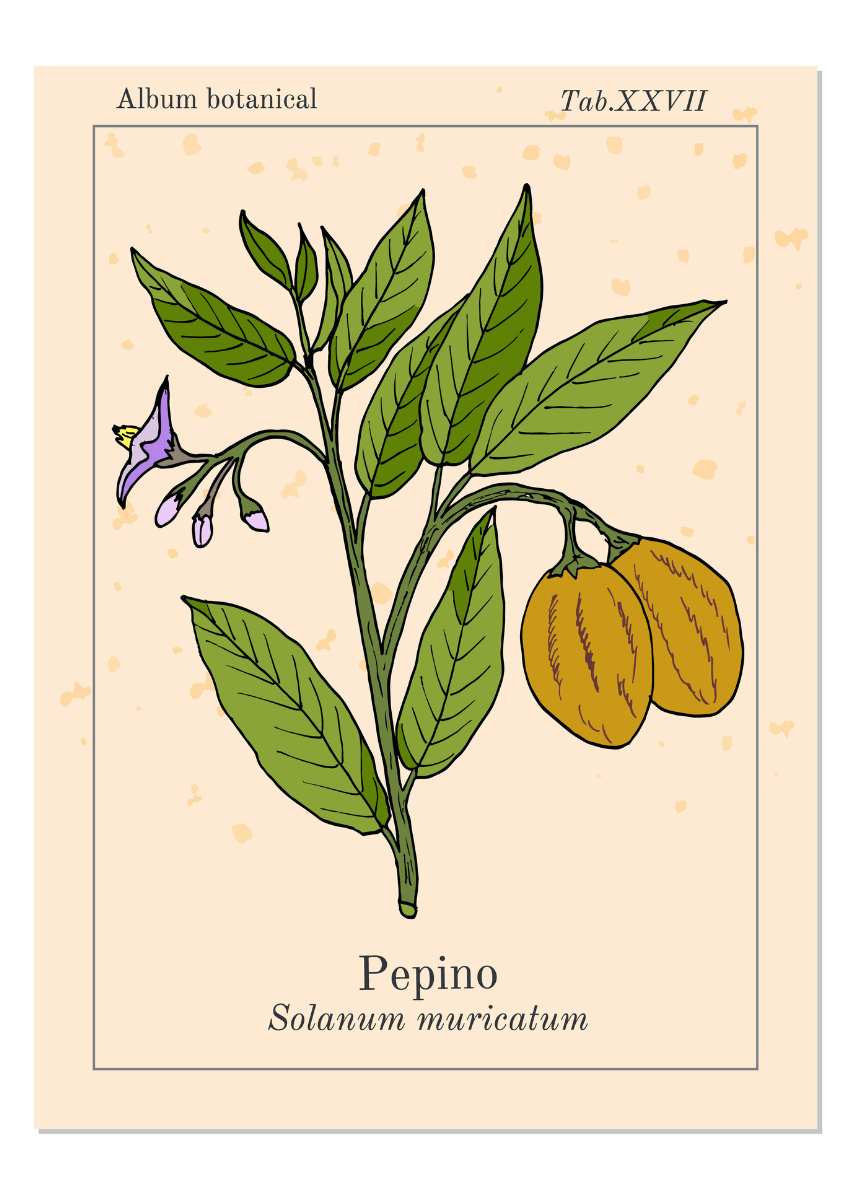
Harvesting and Storing Pear Melons
The harvest of pepino melons occurs at least 4 months after planting, in early autumn. Initially greenish-white in colour, a ripe fruit will have smooth, pale yellow skin with a slight golden hue, distinctly striate with purple. It will be both firm and supple to the touch and easy to detach. Harvest the fruits by cutting the stem with a knife or pair of scissors.
Pepino melons must absolutely be harvested before the first frosts. If they haven’t reached full ripeness, they can still be picked. They will finish ripening indoors in a bright and sufficiently warm room. However, their flavour won’t be the same… and you may find them rather bland.
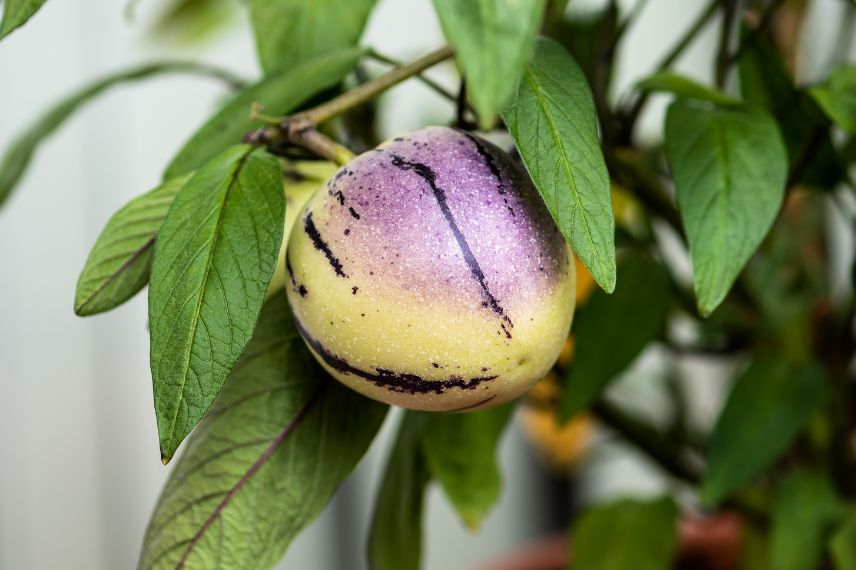
A pepino melon ready for harvest
Bear in mind that the harvest remains unpredictable, as pepino melons require substantial warmth over an extended period.
When harvested at peak ripeness, pepino melons keep well for several weeks when stored at 10°C. These fruits can then be eaten raw or cooked – sautéed, or transformed into jams or sorbets.
- Subscribe!
- Contents
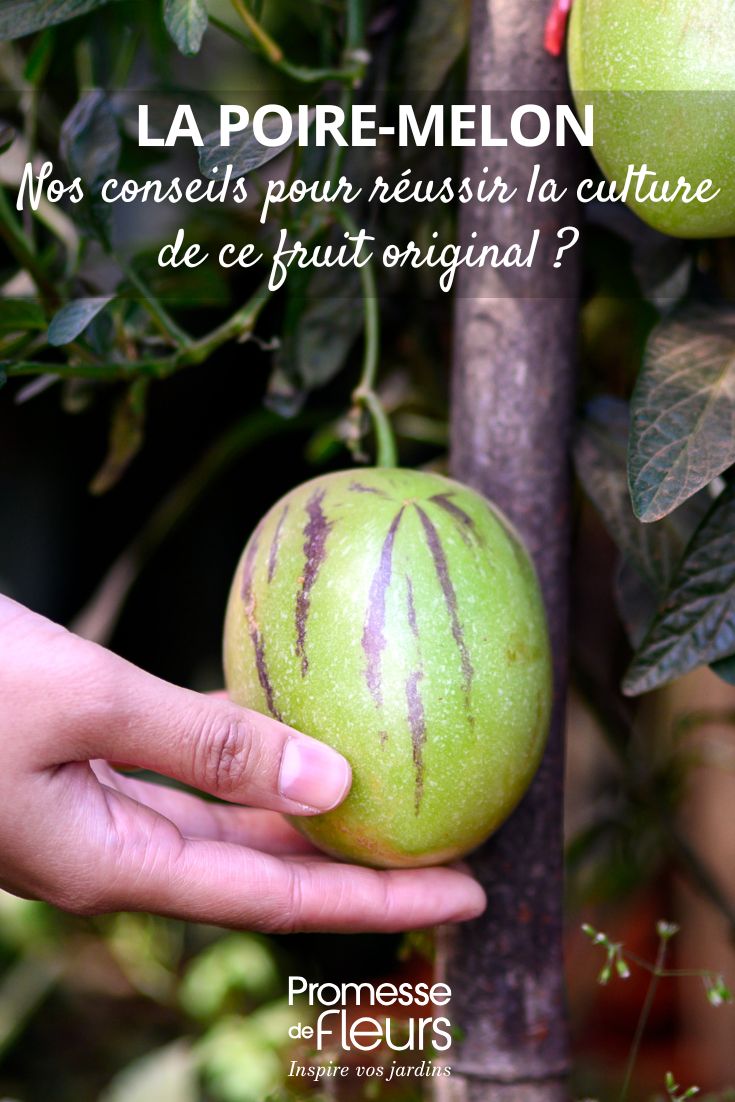


































Comments